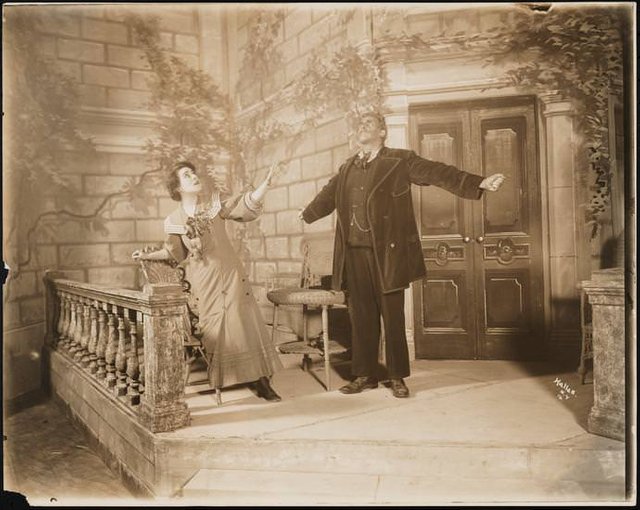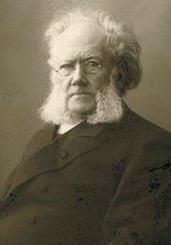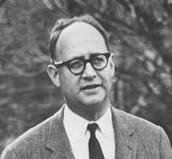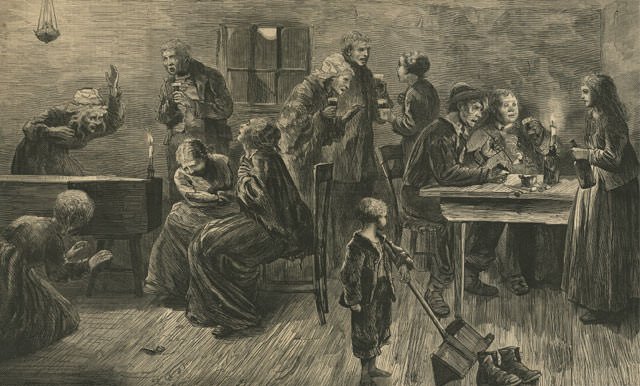
The first four paragraphs of Finnegans Wake comprise the opening prelude of the book. The next four paragraphs retell the story of the Irish-American ballad Finnegan’s Wake. Well, the opening few verses, at any rate: Tim Finnegan’s resurrection will be deferred for several hundred pages:
Tim Finnegan is an Irish emigrant to America. He lives in Walker Street, New York, and is employed as a hodman on a building site. He is a chronic alcoholic, who starts each day with a glass of whiskey. One morning he goes to work quite drunk and falls from a ladder. He breaks his skull and is presumed dead. His friends take him home and prepare his wake. Tim’s “corpse” is wrapped up in a white sheet and laid out on the bed, with a gallon of whiskey at his feet and a barrel of porter at his head. Mrs Finnegan (who may be Tim’s mother or his wife) provides tea, cakes, pipes, tobacco and whiskey punch for the guests, who then commence to dance.
— Such a neat clean corpse did you ever see? says Biddy O’Brien, a young woman who fancied Tim. Arrah, Tim avourneen, why did you die?
It is quite easy to trace the outline of this simple story through the next four paragraphs, from Bygmester Finnegan, of the Stuttering Hand to Tee the tootal of the fluid hang the twoddle of the fuddled, O! (RFW 004.09-005.40). These four paragraphs can also be read as the four parts of a Viconian Cycle.
Henrik Ibsen
Bygmester may sound like a Wakean version of Big Master—an appropriate description of the book’s protagonist, HCE (Campbell & Robinson 37)—but it is also a perfectly good word in Norwegian bokmål, the literary language in which Henrik Ibsen’s plays are written. Bygmester Solness, or The Master Builder, is one of Ibsen’s finest dramas, and a key text for Finnegans Wake. There is considerable overlap in the themes explored by the two works, and the play is well worth reading for the light it casts on Finnegans Wake.
Bygmester is usually translated as master builder or architect. In Einar Haugen’s celebrated Norwegian English Dictionary, the spelling is slightly different than Ibsen’s and the brief definition Haugen gives is quite mundane:
byggmester building contractor (Haugen 92)
Joyce first discovered Ibsen in 1898, when he was sixteen and attending Belvedere College:

But the principal new pressure upon him was the work of Ibsen, another genius who arose from a small, parochial people. Ibsen was then seventy years old, and his name was of course well known in England, less so in Ireland ... [Joyce] caught from Ibsen what he called “a spirit of wayward boyish beauty” that blew through him “like a keen wind” [A Portrait 204]. Although he could read him as yet only in translation, drinking him, as Yeats said, through William Archer’s hygienic bottle, he perceived that his master’s irony went hand in hand with idealism. The notion of artistic honesty carried to the point where it is almost self-defeating encouraged Joyce in his own rigorous self-examination. For him as for Ibsen, truth was then more an unmasking than a revelation. He approved also of the quality of aloofness in Ibsen that led him to leave his country and call himself an exile. Truth as judgment and disclosure, and exile as the artistic condition: these were to be the positive and negative poles of Joyce’s own state of mind. The figure of Ibsen, whose temper, he said in Stephen Hero, was that of an archangel [Stephen Hero 93], occupied for Joyce in art the place that the figure of Parnell had taken on for him in national life. (Ellmann 54)
The importance of Ibsen’s new drama to Joyce’s evolution as a writer cannot be overstated. Joyce himself acknowledges it in the pages of Stephen Hero, an autobiographical novel he worked on between 1904 and 1907, before setting it aside in favour of A Portrait of the Artist as a Young Man.
In the spring of 1900—Joyce, still in his teens, was now attending the Catholic University—the Fortnightly Review published his review of Ibsen’s latest play When We Dead Awaken:

When the Fortnightly Review was published on April 1, 1900, with “Ibsen’s New Drama” by James A. Joyce included in it, his fellow-students were dumbfounded. That he received twelve guineas for it amazed them still more, and encouraged several to try, unsuccessfully, to follow his example. From now on Joyce was the man who had published the article in the Fortnightly and this confirmation of his good opinion of himself encouraged him to stand even more aloof. What exalted him, however, was not their admiration, but a compliment from Ibsen himself. The master wrote from Christiania to Archer on April 16 ... Archer relayed this message to Joyce on April 23: “I think it will interest you to know that in a letter I had from Henrik Ibsen a day or two ago he says _I have read, or rather spelt out, a review by Mr. James Joyce in the Fortnightly Review which is very benevolent (‘velvillig’) and for which I should greatly like to thank the author if only I had sufficient knowledge of the language. (Ellmann 74)
Ellmann observed:
Before Ibsen’s letter Joyce was an Irishman; after it he was a European. He set himself to master languages and literatures, and read so widely that it is hard to say definitely of any important creative work published in the late nineteenth century that Joyce had not read it ... John Joyce gave him money to buy foreign books whether or not the family had enough to eat. James’s signature and the dates 1900 or 1901 appear on plays of Hauptmann (Hanneles Himmelfahrt) and Ibsen (The Master Builder in Dano-Norwegian) ... (Ellmann 75)
Joyce was studying modern languages at college—French and Italian—but he also began to study Dano-Norwegian so that he could read Ibsen in the original. His progress was such that in March 1901 he even wrote a letter to the famous playwright in the language. Ellmann described it as the sort of letter that the recipient discards hastily and the writer files away (Ellmann 87). Only Joyce’s English draft survives.
Joyce never lost his interest in either Ibsen or the language. Many years later, when he visited Copenhagen, he astonished his guide Ole Vinding with the quality of his Danish.
Viconian Cycle
These four paragraphs also delineate Giambattista Vico’s cyclical view of history, according to which human history passes through three phases before collapsing into the chaos of uncivilization, which ultimately leads back to the first phase and the beginning of a new cycle:
- Theocratic Phase, or the Age of Gods
- Aristocratic Phase, or the Age of Heroes
- Democratic Phase, or the Age of Men
- Collapse and Ricorso, or Reflux
In the first paragraph, HCE is described as the godlike creator of a new world. Tim Finnegan does help to build the skyscrapers of New York, so it is not so far-fetched. Moses and the Old Testament are invoked, as are the riverine cities of the ancient World, both Babel in Mesopotamia and the Chinese cities on the Hwang Ho.

The second paragraph is decidedly Medieval, with an emphasis on heraldic scutcheons, and an explicit reference to the Russian hero Vasily Buslayev. Vasily was a bogatyr, the Russian equivalent of the knight-errant of Western folklore. In Vico’s New Science, the type of language characteristic of the Second Age was heroic blazonings, with which arms are made to speak (Vico § 930).
The third paragraph strikes a new tone. The fall of Finnegan from his ladder is treated like a mundane industrial accident that must be inquired into by the relevant authorities. Throughout Finnegans Wake, the Four Old Men spend much of their time carrying out such “Inn Quests” into the activities of the book’s other characters. Here, as always, they are accompanied by their donkey—Cropherb the crunchbracken—who even contributes something to the debate.

The fourth paragraph describes the wake itself, the passage of Tim from this world to the next—or, in Viconian terms, the passage of human history from the end of one cycle to the beginning of the next. Note how this paragraph ends with the letter “O”, an ouroboros that epitomizes Vico’s cycle.
As usual, the details add many more layers of meaning to these paragraphs, some of which we shall explore in the next few articles.
References
- Joseph Campbell, Henry Morton Robinson, Edmund L Epstein (editor), A Skeleton Key to Finnegans Wake, New World Library, Novato CA (2005)
- Richard Ellmann, James Joyce, Second Edition, Oxford University Press, Oxford (1982)
- Einar Haugen, Norwegian English Dictionary, The University of Wisconsin Press, Madison (1965)
- Henrik Ibsen, Hedda Gabler, The Master Builder, Translated by Edmund Gosse and William Archer, Charles Scribner’s Sons, New York (1912)
- Henrik Ibsen, When We Dead Awaken, Translated by William Archer, William Heinemann, London (1900)
- James Joyce, A Portrait of the Artist as a Young Man, B W Huebsch, New York (1916)
- James Joyce, Finnegans Wake, The Viking Press, New York (1958, 1966)
- James Joyce, Stephen Hero, A New Directions Book, James Laughlin, New York (1944)
- Danis Rose, John O’Hanlon, The Restored Finnegans Wake, Penguin Classics, London (2012)
- Giambattista Vico, Goddard Bergin (translator), Max Harold Fisch (translator), The New Science of Giambattista Vico, Cornell University Press, Ithaca NY (1948)
Image Credits
- The Master Builder: Alla Nazimova as Hilde Wangel and Walter Hampden as Halvard Solness in The Master Builder, Bijou Theater, Broadway, © 2018 Alla Nazimova Society, Fair Use
- Henrik Ibsen: Wikimedia Commons, Gustav Borgen (photographer), Public Domain
- Richard Ellmann: Wikipedia, Fair Use
- Vasily Buslayev: © Tatiana Leonidovna Milushina (artist), Kholui School, Fair Use
- An Irish Wake: Wikipedia, Irish Wake, Harpers Weekly, 15 March 1873, Public Domain
Useful Resources
- Joyce Tools
- FWEET
- The James Joyce Scholars’ Collection
- FinnegansWiki
- Annotated Finnegans Wake (with Wakepedia)

It is an extraordinary writing a great writer with very good works and you share it with us friend thanks for such good post greetings..my dear friend. @harlotscurse
Downvoting a post can decrease pending rewards and make it less visible. Common reasons:
Submit
Excellent friend an extraordinary writing I loved thank you for sharing
Downvoting a post can decrease pending rewards and make it less visible. Common reasons:
Submit
wondarful history ..i like it ..thanks for share ..dear @harlotscurse .....i really support you....
Downvoting a post can decrease pending rewards and make it less visible. Common reasons:
Submit
Excellent post good article and photography dear @harlotscurse i appreciate your writing thanks for shere this post....?
I just #Resteem ans #Upvote..?
Downvoting a post can decrease pending rewards and make it less visible. Common reasons:
Submit
Thanks for your comment:
Downvoting a post can decrease pending rewards and make it less visible. Common reasons:
Submit
Greetings, friend, congratulations, magnificent story, a high-level writing, success for you
Downvoting a post can decrease pending rewards and make it less visible. Common reasons:
Submit
Excellent history and very nice article D:) @harlotscurse . I love your post. Thank you for sharing with us "
Downvoting a post can decrease pending rewards and make it less visible. Common reasons:
Submit
A beautiful story, excellent friend, when I see the name of the great James Joyce, it is a great writing, I admire that writer, his works are magnificent, thank you for sharing with us such important things.
Downvoting a post can decrease pending rewards and make it less visible. Common reasons:
Submit
Wonderful history and very nice article. Thank you for sharing with us "
Downvoting a post can decrease pending rewards and make it less visible. Common reasons:
Submit
Excellent post good article and photography dear @harlotscurse i appreciate your writing thanks for shere this post....?
Downvoting a post can decrease pending rewards and make it less visible. Common reasons:
Submit
Such a wonderful history. Thanks for share this post.
Downvoting a post can decrease pending rewards and make it less visible. Common reasons:
Submit
Very nice history really I like it " thank you for sharing with us
Downvoting a post can decrease pending rewards and make it less visible. Common reasons:
Submit
Very complete information, I really liked how you endeavor to explain each paragraph, I congratulate you for doing a wonderful job.
Downvoting a post can decrease pending rewards and make it less visible. Common reasons:
Submit
Excellent history .it is an extraordinary writing a great writer with very good works and you share it with us friend thanks for such good post greetings
Downvoting a post can decrease pending rewards and make it less visible. Common reasons:
Submit
Excellent analysis, the way you tell the story is fascinating. I fully understand the explanation of each paragraph, I really like to read your posts because I learn a lot about history. Greetings friend! I am anxious to read more of this in your next publications
Downvoting a post can decrease pending rewards and make it less visible. Common reasons:
Submit
Awesome history Thanks for share
Downvoting a post can decrease pending rewards and make it less visible. Common reasons:
Submit
Excellent post dear. How r u buddy. I hope u okay
Downvoting a post can decrease pending rewards and make it less visible. Common reasons:
Submit